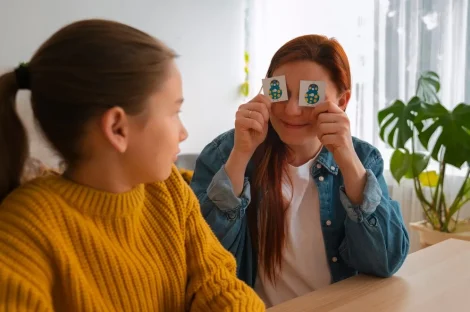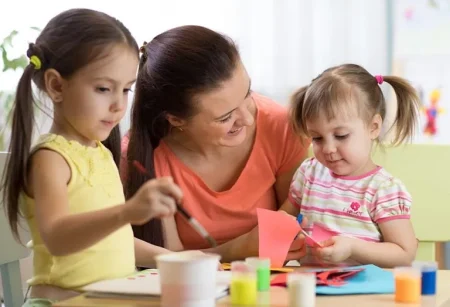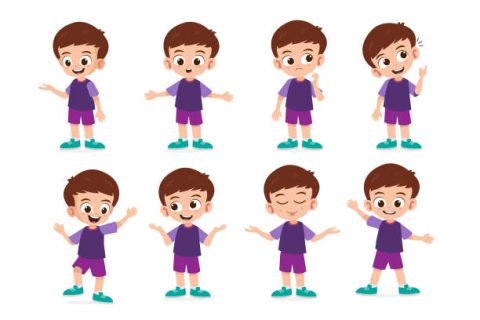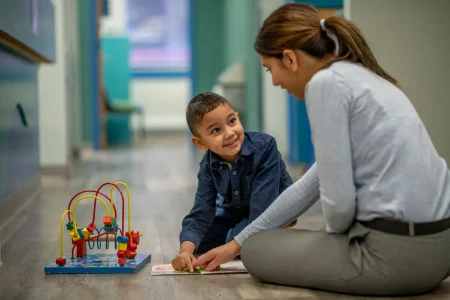Eye contact plays a vital role in shaping how children communicate and connect with the world around them. It is more than just looking into someone’s eyes—it reflects attention, respect, and understanding. Developing strong eye contact communication skills helps children express themselves clearly, build trust, and engage meaningfully in conversations. When a child understands what eye contact in communication skills means, they learn to pick up social cues, interpret emotions, and respond appropriately in different situations.
In today’s world, where social interaction is the key to academic growth and future career success, mastering eye contact can give children a lasting advantage. Eye contact improves listening skills, boosts confidence, and creates a sense of empathy, helping children strengthen friendships and relationships. Parents and educators who focus on why eye contact is important in communication can guide children to practice it naturally, making them more socially adaptable and emotionally intelligent. By nurturing this essential skill early, you prepare your child for a stronger social foundation, ensuring they are confident, expressive, and ready to thrive in their personal and professional future.
What is Eye Contact in Communication Skills?
Eye contact in communication skills refers to maintaining visual connection with another person during conversation. It is one of the most powerful non-verbal cues, often saying more than words. Good eye contact shows interest, respect, confidence, and empathy.
For children, this skill can be challenging, especially for those with social or developmental difficulties such as autism or ADHD. However, with the right guidance, every child can improve this skill and use it effectively in daily life.
Examples of eye contact in communication skills:
- A child answering their teacher’s question while looking into their eyes.
- Greeting relatives with a smile and direct eye contact.
- Making friends at school by showing attentiveness during conversations.
By practicing consistently, children learn that eye contact makes interactions smoother and helps them feel more connected to others.

Why is Eye Contact Important in Communication?
Parents often wonder, why is eye contact important in communication? The answer lies in its ability to bridge emotions and understanding. Here’s why it matters:
- Builds Trust and Respect
When a child maintains eye contact, it shows honesty and sincerity. It reassures the listener that the child is attentive and genuine. - Boosts Self-Confidence
Children who practice eye contact naturally appear more confident. This reduces social anxiety and helps them express themselves more openly. - Encourages Active Listening
Teachers often gauge attention through eye contact. A child who maintains it demonstrates focus and engagement, which leads to better academic performance. - Enhances Emotional Understanding
Eye contact is essential for recognizing facial expressions and emotions. It helps children understand feelings like happiness, sadness, or concern, leading to stronger empathy. - Strengthens Social Bonds
Friendships and peer relationships thrive on mutual respect and understanding, both of which are reinforced through proper eye contact.
Eye contact is more than looking at someone—it builds trust, boosts confidence, improves listening, and helps children understand emotions, forming the foundation for strong social connections.

How Eye Contact Communication Skills Shape a Child’s Social Future?
Eye contact may seem small, but its impact is lifelong. Strong eye contact communication skills can help children in:
- School Life: Teachers interpret eye contact as attentiveness. It also helps in participating in group discussions and presentations.
- Friendships: Maintaining eye contact during conversations makes peers feel valued, fostering trust and stronger bonds.
- Future Career: In interviews, meetings, and public speaking, eye contact reflects professionalism and credibility.
- Leadership Roles: Leaders are often recognized by their ability to connect, inspire, and gain trust—all of which start with eye contact.
On the other hand, poor eye contact can lead to misunderstandings, social withdrawal, or lack of confidence. Children who avoid eye contact may be perceived as shy, disinterested, or insecure, even if they are capable and intelligent.

Practical Tips for Parents to Encourage Eye Contact
Helping children build eye contact doesn’t have to be stressful. Parents can gently encourage it in everyday routines:
- Play “Look into My Eyes” Games: Make it fun by challenging your child to maintain eye contact while singing or telling a story.
- Model Good Eye Contact: Children learn by watching. When you talk to them, maintain warm, natural eye contact.
- Use Positive Reinforcement: Praise your child whenever they make eye contact. This builds confidence.
- Role-Play Conversations: Practice greetings, introductions, and storytelling where eye contact is essential.
- Gradual Exposure: For children who feel anxious, start with short moments of eye contact and increase gradually.
Practicing eye contact can be fun and stress-free. Using games, modeling, positive reinforcement, role-play, and gradual exposure, parents can help children develop confidence and strong eye contact communication skills that improve social interactions.
How Nurturers Build Eye Contact Communication Skills in Children?
At Nurturers, we provide a safe and supportive environment for children to develop essential communication skills, including eye contact. Our special educators and therapists use:
- Role-Playing Activities: Children practice real-life scenarios such as greetings, classroom discussions, and storytelling.
- Group Sessions: Encourages peer interaction, making eye contact feel more natural.
- Speech and Language Therapy: Supports children with communication difficulties, including those struggling with eye contact.
- Sensory Strategies: For children with autism or sensory challenges, we create step-by-step approaches to reduce discomfort while practicing eye contact.
At Nurturers, children develop eye contact communication skills through role-play, group sessions, speech therapy, sensory strategies, and consistent encouragement, helping them build confidence and apply these skills naturally in everyday interactions.

Conclusion
Eye contact is a powerful communication skill that can shape a child’s confidence, relationships, and overall social and academic success. By understanding what eye contact is in communication skills and recognizing why eye contact is important in communication, parents can actively support their children in developing this essential ability. At Nurturers, we guide children through structured activities, role-play, and supportive strategies, helping them practice eye contact naturally while building self-confidence and social awareness. When children master these skills, they are better prepared to interact, express themselves, and thrive in school, friendships, and future professional environments. After all, a child’s social future often begins with the simple yet powerful act of looking into someone’s eyes.